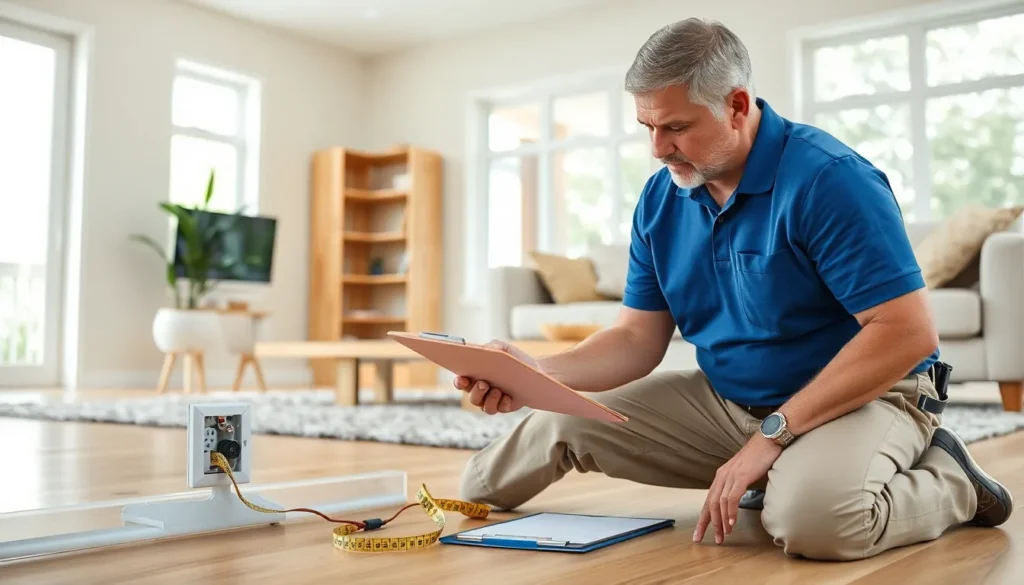Navigating the world of real estate can feel like stepping into a game show where the stakes are high and the prizes can be a bit dodgy. When it comes to securing a place to live, two key players enter the ring: the home inspection and the rental walkthrough. Both promise to unveil the hidden secrets of a property, but they do so with vastly different styles.
Imagine a home inspection as the meticulous detective, armed with tools and a keen eye for detail, ready to uncover every creaky floorboard and questionable plumbing. On the flip side, the rental walkthrough is more like a friendly tour guide, casually pointing out the charm of the living room while secretly hoping you don’t notice the suspicious stain on the carpet. Understanding the differences between these two can save anyone from a future filled with unexpected surprises.
Table of Contents
ToggleOverview of Home Inspections
Home inspections play a critical role in the real estate process, focusing on identifying potential issues in a property. These inspections often occur before purchasing a home to ensure buyers make informed decisions.
Purpose of Home Inspections
The primary aim of home inspections involves uncovering hidden problems within a property. Buyers gain valuable insights into the condition of elements such as roofs, electrical systems, and plumbing. By addressing these concerns early, homeowners can avoid costly repairs in the future. Additionally, lenders may require inspections as part of loan approval, ensuring the property’s value aligns with the investment.
Process of Home Inspections
Performing a home inspection involves a systematic approach to evaluate various components of a house. Inspectors typically spend two to four hours examining the property. They assess structures, systems, and appliances, looking for compliance with safety standards. After completing the inspection, an extensive report outlines findings and recommendations. This report equips buyers with essential information to make informed decisions regarding potential negotiations or repairs.
Understanding Rental Walkthroughs
Rental walkthroughs serve as a crucial overview of a property prior to leasing. These assessments allow potential tenants to familiarize themselves with the space, ensuring it meets their expectations.
Purpose of Rental Walkthroughs
Rental walkthroughs aim to provide tenants with an opportunity to evaluate a property’s condition. This process allows renters to identify any existing damages or necessary repairs. Landlords also use this assessment to confirm that rental properties remain in good condition and meet safety standards. By highlighting features and amenities, landlords can display the property’s appeal while addressing any concerns. This clear communication fosters trust between landlords and potential tenants, reducing misunderstandings.
Process of Rental Walkthroughs
The rental walkthrough process typically involves scheduling a time to visit the property with the landlord or property manager. During the walkthrough, participants inspect rooms, appliances, and common areas. They check for cleanliness and functionality, ensuring that everything works properly. Both parties may document existing damage to avoid future disputes regarding security deposits. Completion of a checklist or report summarizes findings, creating a record of the property’s condition at the start of the lease. This structured approach promotes transparency, benefiting both the landlord and tenant.
Key Differences Between Home Inspection and Rental Walkthrough
Home inspections and rental walkthroughs serve distinct purposes in the property management process. They each offer unique insights, focusing on different aspects of a property.
Scope of Inspection
Home inspections thoroughly examine a property’s structural integrity and essential systems. Inspectors assess roofs, foundations, plumbing, and electrical systems to identify potential issues. This comprehensive analysis provides buyers with critical information for informed decision-making. In contrast, rental walkthroughs emphasize the property’s current condition from a tenant’s perspective. These evaluations mainly focus on aesthetic concerns and noticeable wear and tear. Tenants inspect living spaces to pinpoint existing damage before committing to a lease. This focused approach allows both landlords and tenants to establish a mutual understanding of the property’s state.
Timing and Frequency
Home inspections typically occur before a property purchase, ensuring any structural or mechanical issues are addressed upfront. Buyers often schedule inspections once their offer is accepted, allowing time for negotiations based on findings. Conversely, rental walkthroughs take place before the lease begins, promoting transparency between landlords and tenants. Scheduling these walkthroughs early in the leasing process minimizes potential disputes later. Additionally, rental walkthroughs may occur during periodic inspections to verify ongoing property maintenance and condition. This regular check supports a healthy landlord-tenant relationship while maintaining the property’s value.
Benefits of Home Inspections
Home inspections provide several significant advantages to buyers, enhancing their understanding of a property’s condition and ensuring informed decisions.
Peace of Mind for Buyers
Home inspections foster confidence in buyers during the purchasing process. Knowing that a professional has evaluated the property reduces anxiety about hidden issues. Inspectors examine structural components and essential systems, ensuring everything operates correctly. They’ll identify potential dangers like mold or faulty wiring, allowing buyers to address these concerns before finalizing a deal. Comprehensive reports from inspectors detail findings, offering clarity on the property’s condition and serving as negotiation tools. Buyers enjoy peace of mind, establishing a stronger sense of security when committing to a purchase.
Long-Term Cost Savings
Home inspections lead to substantial long-term savings for buyers. Identifying existing problems early can prevent costly repairs later on. For instance, discovering roof damage during an inspection allows for immediate negotiation or repair planning. Proactive solutions often reduce expenses compared to addressing issues after moving in. Inspectors highlight necessary upgrades or maintenance, guiding buyers in budgeting for future expenses. Investing in an inspection frequently pays dividends, as it ensures a home’s systems function properly. Overall, home inspections play a vital role in protecting buyers’ financial interests.
Benefits of Rental Walkthroughs
Rental walkthroughs offer significant advantages for both tenants and landlords. These assessments promote clarity and help establish expectations before entering a lease agreement.
Tenant Protection
Tenant protection serves as a key benefit of rental walkthroughs. Documenting existing damage during the walkthrough safeguards tenants from being held responsible for pre-existing issues. This process creates a clear record, reducing disputes over security deposits. Accurately noting all defects helps protect a tenant’s financial interests throughout the lease period. Moreover, having a mutual understanding of the property’s condition fosters trust between the landlord and tenant.
Ensuring Property Upkeep
Ensuring property upkeep is another essential benefit of rental walkthroughs. Property managers assess the condition during these visits and address any necessary repairs before new tenants move in. Regular assessments promote maintenance and enhance overall living conditions. Routine inspections help maintain the property’s value over time. Additionally, they create an opportunity for landlords to uphold safety standards, benefiting tenants’ well-being and creating a positive rental experience.
Conclusion
Understanding the differences between home inspections and rental walkthroughs is essential for anyone navigating the real estate landscape. Home inspections serve as a critical tool for buyers to uncover potential issues before making a significant investment. They provide valuable insights that can lead to informed decisions and financial savings.
On the other hand, rental walkthroughs play a vital role in fostering transparency and trust between tenants and landlords. By documenting the property’s condition, both parties can avoid misunderstandings and ensure a positive rental experience. Recognizing these distinctions empowers individuals to make better choices whether buying a home or renting a property.









